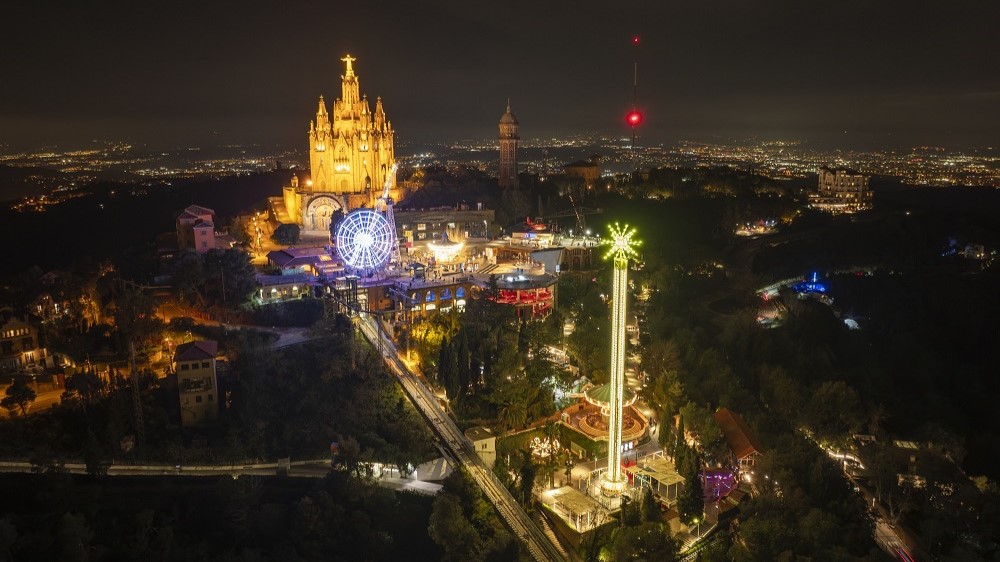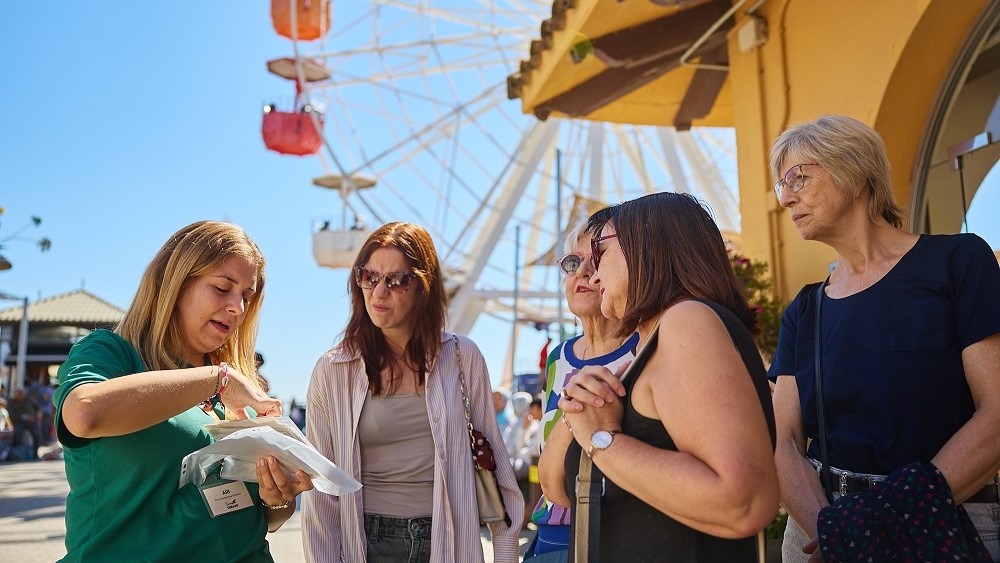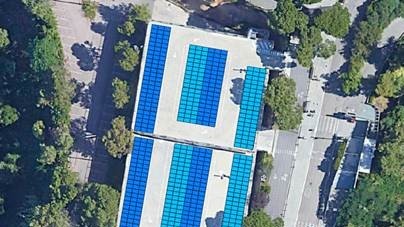The Tibidabo Amusement Park aims to reduce its environmental impact. This goal includes the need to control the consumption of resources - both water and electricity - and to make it as efficient as possible.

Renewable source of electricity
In a world increasingly aware of environmental challenges, the origin of the electricity we consume has become a key factor in moving towards a sustainable future. Renewable electricity—produced from sources such as the sun, wind, water or biomass—represents a clean and responsible alternative to fossil fuels, which are limited and highly polluting. One of the main benefits of renewable electricity is the reduction of greenhouse gas emissions, which are responsible for climate change. By not depending on the burning of coal, oil or natural gas, renewable energies contribute significantly to reducing the carbon footprint of homes, businesses and industries.
At Tibidabo Amusement Park, all the electricity consumed comes from 100% renewable sources and we have the relevant GdO certificates of origin. This means that the carbon footprint associated with the electricity consumption of our activity is ZERO.
The origin of our electricity is:
- 74.7% wind
- 24.76% hydraulic
- 0.5% solar thermoelectric and solar photovoltaic

Telematic consumption control (both water and electricity)
At the Tibidabo facilities, we have implemented a system for controlling water and electricity consumption electronically —through smart meters and a digital platform. This implementation offers us multiple advantages:
- Economic savings: Allows you to detect excessive or unnecessary consumption and adjust habits to reduce bills.
- Real-time monitoring: Facilitates instant monitoring of consumption, both water and electricity, and helps identify leaks or anomalies.
- Sustainability: Promotes a more responsible use of natural resources, contributing to the reduction of environmental impact.
- Smart management: Allows you to program devices, optimize use according to rates and integrate savings systems.
- Alerts and security: Some platforms warn of unusual consumption, water leaks or electrical overloads, improving the security of the home or company.
In short, digital consumption control is a key tool for moving towards more intelligent, efficient and sustainable management of basic resources.
It should be remembered that, in addition, our Jardí Vertical is one of the eight case studies of the European project BIG4LIFE, which aims to analyze thermal gradient and water consumption data to implement good practices that generate efficient use.

Energy audits
Tibidabo Amusement Park has always worked to improve the energy efficiency of its facilities and equipment, reducing the environmental impact and achieving the maximum possible savings. However, due to Royal Decree 56/2016, we had to carry out several energy audits in the various buildings and locations of the Park.
Within the standard analysis and, in addition to compliance with regulations - also taking into account the requirements established in 390/2021 relating to the certification of the energy efficiency of buildings, the following fields are analyzed:
- Distribution of energy consumption by installation and by energy source: an energy balance is carried out for the different installations, quantifying consumption by sectors (refrigeration, heating, ventilation, lighting, IT equipment, domestic hot water, etc.) and by energy source used, as a first step to focus future savings strategies.
- Optimization of energy supply points (electricity and gas): study of consumption, types of meters, load curve and optimization of contracted power; reactive energy and need for capacitor banks, if necessary.
- Optimization of Construction Elements: reduction of solar gloves (sun protection and enclosures) reduction of infiltrations, insulation and modifications proposed appropriate to each installation considering the climatology at the Tibidabo Summit, as well as the orientations of the facades.
- Equipment Optimization: overall performance, energy consumption, thermal energy losses (cold rooms, heated fluid distribution circuits, etc.), frequency regulators in motors (lifts, elevators, fans, pumps, etc.), possible adaptations of existing ones or technical proposal for replacement in case they are obsolete.
- Optimization of Air Conditioning installations (cold and hot): adaptation of the equipment to the required load, adaptation of seasonality in the area, efficiency of generator and terminal equipment, regulation of impulse and ventilation flow rates by zones, adaptation of T° in zones through thermostats (appropriate location and adjustment), appropriate distribution of the refrigerant fluid through the installations (insulation, pressure losses), presence control in the different compartments (card and/or sensors), maintenance and cleaning.
- Lighting Optimization: lighting levels, lighting quality, adaptation to ornamental requirements, efficiency of lights and auxiliary equipment, zoning of distribution and control for similar needs (lobbies and corridors, common areas, offices, kitchens...), ignition systems, automation, use of natural light, cleaning and maintenance of lights and luminaires, stabilization and regulation of voltage in lighting lines.
- Renewable energies: identification of opportunities for expansion and implementation of other renewable energy installations (for example new locations for photovoltaic solar energy installations, study of other renewable energy sources such as geothermal energy, etc.).
- Optimization of Water Consumption: analysis of supply policies, types of meters and their billing, study and adaptation of water volume consumption in m3 according to type of activities and seasonality, quality of facilities and possible adaptations of existing ones or replacements in case they are obsolete or have leaks and identification of activities with higher consumption, as well as analysis of the irrigation system, services, changing rooms and other facilities that require the use of water for their operation.
- Good practices and protocols for control and management action: measures for the efficient use of energy, directly related to changes in personnel behavior and conduct, and use and maintenance of facilities, without investments or practically zero investments.

During June 2022, a preliminary study was written, with the aim of preparing a preliminary analysis of the technical and economic feasibility for the photovoltaic solar installation on different spaces of the Tibidabo Amusement Park. 4 locations were studied:
- The CIM parking lot (differentiating 2 types of technical solutions: a conventional parking pergola, and a solution to completely cover the parking space, with an east-west (E/W) orientation system).
- Muntanya Russa area, considering occupying a pergola space.
- TibiCity area.
- Masia building.
The study concluded that the optimal option was the location of the CIM Parking Lot – with conventional photovoltaic pergolas, instead of covering the entire surface –, as well as the self-consumption modality, the option with the shortest return on investment and the highest profitability.
The start of works to carry out the installation of this photovoltaic field, which would supply 17% of the total electricity consumption necessary for the Park's annual activity, is planned for the end of 2025, with a total duration of approximately one year.
